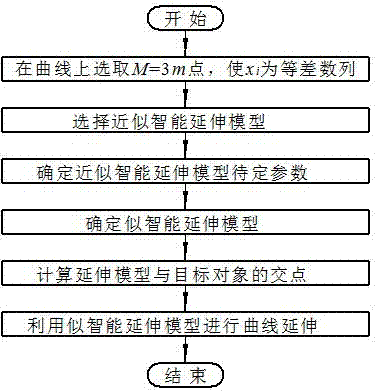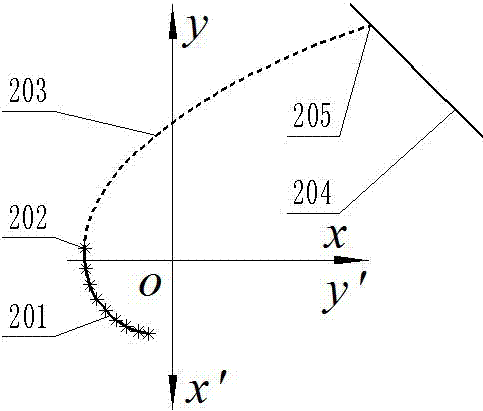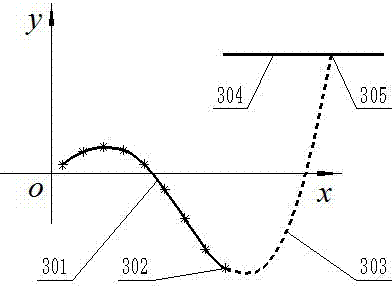Method for non-circular curve trend extrapolation similarity intelligent extension
A trend extrapolation and curve technology, applied in the field of 3D modeling, can solve the problems of high labor intensity, low precision, low efficiency of drawing and modeling for designers, etc.
- Summary
- Abstract
- Description
- Claims
- Application Information
AI Technical Summary
Problems solved by technology
Method used
Image
Examples
Embodiment 1
[0036] See attached figure 2 , the expression of curve 201 to be extended in this embodiment is , [-33.000, -7.027]; the target object 204 expression is ; The trend extrapolation approximate intelligent extension includes the following steps:
[0037] (1) Calculate the characteristic axis of the curve 201 and y Axis angle =-90°, establish a Cartesian affine coordinate system with the coordinate origin , select 9 points on the curve 201: (21.624, -7.027), (18.333, -17.442), (15.042, -22.116), (11.751, -25.383), (8.460, -27.842), (5.169, -29.732), (1.878, -31.17), (-1.413, -32.250), (-4.704, -33.000), the 9 points are in the coordinate system The middle abscissa is an arithmetic sequence;
[0038] (2) Judging the application conditions of the non-circular curve extension model: the above-mentioned selection of 9 point sequences second difference of The maximum difference is 7.840×10 -4 , the third order difference The maximum difference is 1.170×10 -2 , logar...
Embodiment 2
[0044] See attached image 3 , the expression of the non-circular curve 301 to be extended in this embodiment is , [1.000, 4.800]; target object 304 expression is ; The trend extrapolation approximate intelligent extension includes the following steps:
[0045] (1) Select 9 points on the non-circular curve 301 to be extended: (1.000, 0.842), (1.475, 1.468), (1.950, 1.812), (2.425, 1.593), (2.900, 0.694), (3.375, - 0.781), (3.850, -2.505), (4.325, -4.005), (4.800, -4.782), the abscissa of the 9 points is an arithmetic sequence;
[0046] (2) Judging the application conditions of the non-circular curve extension model: the above-mentioned selection of 9 point sequences second difference of The maximum difference is 0.001, the third order difference The maximum difference is 1.760×10 -5 , logarithmic first order difference The maximum difference is 8.214, logarithmic first order difference ratio of The maximum difference is 5.518, comparing the calculation resul...
Embodiment 3
[0052] See attached Figure 4 , the expression of the non-circular curve 401 to be extended in this embodiment is , [-0.198, 0.281]; target object 404 expression is ; The trend extrapolation approximate intelligent extension includes the following steps:
[0053] (1) Select 9 points on the non-circular curve 401 to be extended: (-0.198, 0.140), (-0.138, 0.149), (-0.078, 0.164), (-0.018, 0.184), (0.042, 0.209), (0.102, 0.238), (0.162, 0.272), (0.221, 0.309), (0.281, 0.351), the abscissa of the 9 points is an arithmetic sequence;
[0054] (2) Judging the application conditions of the non-circular curve extension model: the above-mentioned selection of 9 point sequences second difference of The maximum difference is 1.003×10 -5 , the third order difference The maximum difference is 0.002, logarithmic first order difference The maximum difference is 7.096×10 -8 , logarithmic first order difference ratio of The maximum difference is 0.003, comparing the calculat...
PUM
 Login to View More
Login to View More Abstract
Description
Claims
Application Information
 Login to View More
Login to View More - R&D
- Intellectual Property
- Life Sciences
- Materials
- Tech Scout
- Unparalleled Data Quality
- Higher Quality Content
- 60% Fewer Hallucinations
Browse by: Latest US Patents, China's latest patents, Technical Efficacy Thesaurus, Application Domain, Technology Topic, Popular Technical Reports.
© 2025 PatSnap. All rights reserved.Legal|Privacy policy|Modern Slavery Act Transparency Statement|Sitemap|About US| Contact US: help@patsnap.com



